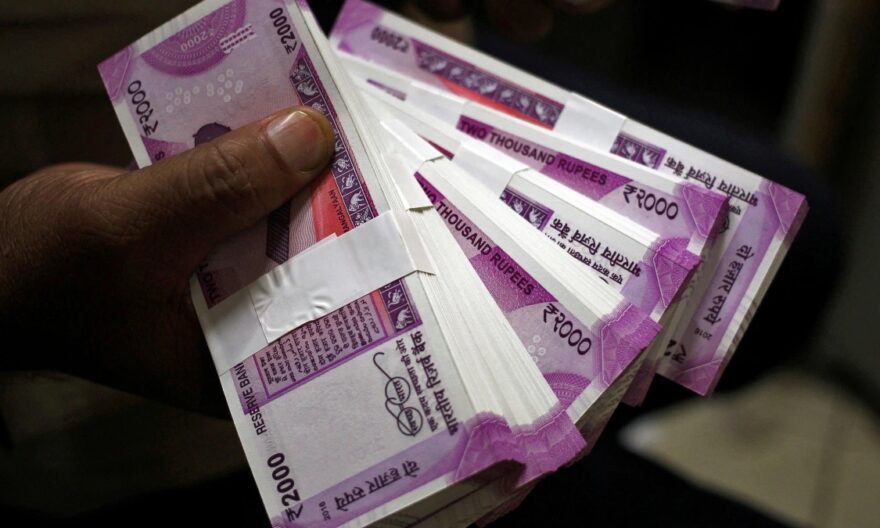
The recent withdrawal of Rs 2000 banknotes has been analyzed by SBI Research in a report, which argues that this move could have several positive impacts on bank deposits, loan repayment, consumption, the usage of RBI’s retail digital currency, and overall economic growth.
RBI Governor Shaktikanta Das recently stated that 50 percent of the Rs 2000 banknotes to be withdrawn had already returned to the system since the announcement on May 19. Out of those returns, approximately 85 percent were through bank deposits.
Governor Das mentioned, ” “Totally so far about Rs 180,000 crore of Rs 2000 notes have come back. This is roughly about 50 per cent of the Rs 2000 notes which were in circulation on March 31.” He also added that approximately 85 percent of these notes have been deposited in bank accounts on a provisional basis.
Based on the comments made by the RBI governor, SBI Research, in its recent Ecowrap report authored by Group Chief Economic Adviser Soumya Kanti Ghosh, asserts that deposits are expected to increase. The report states, ” Though some amount would be withdrawn following the deposit, but going by the current trends, CASA deposits are likely to increase (Rs 1.5 lakh crore) due to this measure.”
According to the report, which refers to data from All Scheduled Commercial Banks (ASCB), there has been a significant increase in total deposits amounting to Rs 3.3 lakh crore during the fortnight ending June 2, 2023.
The report states, ” The average increase in deposits during the same fortnight in the last two years was around Rs 1.5 lakh crore. Thus, taking that also into account, banks may have received additional deposits of around Rs 1.8 lakh crore during the fortnight this year. It seems Corporates, flush with in-hand liquidity, are parking the additional funds with Banks.”
In addition to the deposits of Rs 2000 banknotes, certain sectors such as Refinery, Oil and Gas, Power, and Chemicals, which have reported improved cash and bank balances, are believed to be actively depositing funds with banks.
Regarding credit, SBI Research estimates that around 30 percent of the deposits (equivalent to Rs 92,000 crore) could be used for loan repayments. The report argues that despite the frontloading of repayments, credit growth continues to remain strong.
Furthermore, the report suggests that one of the major benefits of the withdrawal of Rs 2000 banknotes could be an immediate boost in consumption demand.
Estimates indicate that consumption demand could be frontloaded by Rs 55,000 crore.
According to the report, “With the banknote remaining a legal tender, unlike demonetization, consumption could see a boost. Though, RBI asked customers to deposit or exchange the Rs 2000 notes, but it is expected that high-value amounts could move to high-value spends such as gold/jewellery, high-end consumer durables like AC, mobile phones etc, and real estate.”
The report suggests that cash transactions at fuel stations, cash on delivery purchases, temple donations, and various miscellaneous purchases are also likely to rise.
The total value of Rs 2000 banknotes in circulation has decreased from its peak of Rs 6.73 lakh crore on March 31, 2018 (37.3 percent of total notes in circulation) to Rs 3.62 lakh crore, constituting only 10.8 percent of total notes in circulation as of March 31, 2023. It was observed that this denomination was not commonly used for everyday transactions.
Currently, people can exchange or deposit their Rs 2000 notes at bank branches and regional branches of the RBI. Even non-account holders can exchange Rs 2000 banknotes up to a limit of Rs 20,000 at any bank branch.
The RBI has stated that the exchange facility will be available until September 30, 2023, and the notes will continue to be legal tender. However, the RBI may reconsider the September deadline based on future circumstances.
It is important to note that the demonetization drive in 2016 and the withdrawal of Rs 2000 notes are not the same. In 2016, the legal tender status of Rs 500 and Rs 1000 notes was withdrawn from the very beginning. In contrast, the Rs 2000 notes continue to be legal tender and can be used for transactions.
The RBI governor recently mentioned “Good thing is that there has been no rush in any of the banks” and appealed to people not to panic or create a last-minute rush at bank branches.




